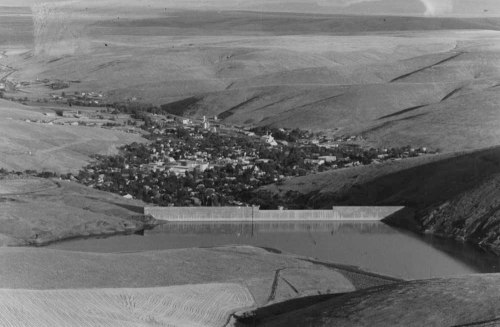Heat wave joins list of Oregon’s deadliest natural disasters; the worst remains Heppner Flood of 1903
Published 3:00 pm Monday, July 5, 2021

- A dam now helps protect Heppner from flooding.
PORTLAND — Oregon has a long history of terrible natural disasters, and almost all of them come in one of four bitter flavors: flood, fire, windstorm and earthquake.
But now, with the temperature getting as high as 116 degrees in the past week, a heat wave can be added to the list of the worst that Mother Nature has thrown at the Pacific Northwest. The brutal temps led to the deaths of at least 95 people in Oregon, making the hot weather one of the deadliest events the state has ever seen.
The worst loss of life from natural disasters in Oregon’s recorded history comes from flooding, and the ultimate such event, taking place in the small Morrow County town of Heppner, is linked to summertime heat, not winter rain or snow.
Heppner is proud of its proximity to the Blue Mountains, embracing the nickname “Gateway to the Blues.”
In 1903, that gate swung the wrong way.
Willow Creek emerges from the Blue Mountains southeast of Heppner. In the summer there’s usually not much water in the creek, which winds through the town. It trickles and meanders. Typically, notes The Oregon Encyclopedia, it “runs only ankle-deep by mid-June.”
Spring had been particularly warm and dry in the region that year. So while “cloudbursts” were known to occur in the semi-arid area during the summer, no one on Sunday, June 14, 1903, expected the skies to suddenly darken and then open up with rain and — despite 90-degree weather — hail over an area “of at least 40 square miles and continuing with the utmost intensity for more than an hour.”
Water and debris roared down dry, overgrazed rangeland and poured into Willow Creek, speeding it toward Heppner. The result, the Heppner Gazette later reported, was a “foaming wall of water” hitting the prosperous county seat at 5 o’clock in the afternoon.
The town’s location, author Joann Green Byrd pointed out in her book “Calamity: The Heppner Flood of 1903,” turned out to be “a natural bull’s-eye for flash floods.” (A dam to head off flooding was finally completed in 1983.)
Devastation from the flood on that broiling Sunday was apocalyptic. Trees and telegraph lines fell. Houses crumpled and floated away. All escape routes, survivors said, had disappeared in an instant. The roar of the water and debris blotted out townspeople’s cries for help.
The death toll from the disaster ranges in accounts between 238 and 251 — in a town of about 1,400 people. Three of the victims were former Morrow County sheriffs.
The day after the Heppner flood, a correspondent for The Oregonian arrived to survey the scene. The resulting account called Heppner “a city of the dead” and described rotting corpses strewn about the town and washed miles away.
“Meantime,” the reporter added, “Willow Creek, as if to mock the dead, has returned to a purling brooklet.”
The Pacific Northwest’s deadliest natural disasters, along with the just-ended heat wave, include a 1910 avalanche in Wellington, Washington, that killed 96 train passengers and rail workers, the 1980 Mount St. Helens eruption that took 57 lives, and the 1962 Columbus Day storm, which killed 46 in Oregon and Washington.





